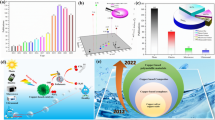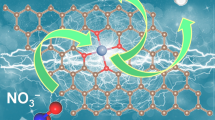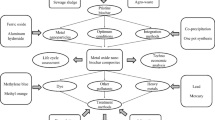Abstract
Heterogeneous Fenton or Fenton-like reagents consist of a mixture of an iron-containing solid matrix and a liquid medium with H2O2. The Fenton system is based on the reaction between Fe2 + and H2O2 to produce highly reactive intermediate hydroxyl radicals ( ∙ OH), which are able to oxidize organic contaminants, whereas the Fenton-like reaction is based on the reaction between Fe3 + and H2O2. These heterogeneous systems offer several advantages over their homogeneous counterparts, such as no sludge formation, operation at near-neutral pH and the possibility of recycling the iron promoter. Some doping transition cations in the iron oxide structure are believed to enhance the catalytic efficiency for the oxidation of organic substrates in water. In this work, goethites synthesized in presence of niobium served as precursors for the preparation of magnetites (niobian magnetites) via chemical reduction with hydrogen at 400°C. These materials were used as Fenton-like catalysts. Both groups of (Nb, Fe)-oxide samples were characterized by 57Fe Mössbauer spectroscopy at 298 K. The results show that increasing niobium contents raise the catalytic potential for decomposition of methylene blue, which was, in this work, used as a model molecule for organic substrates in water.
Similar content being viewed by others
References
Cornell, R.M., Schwertmann, U.: The Iron Oxides, 2nd edn. Wiley-VCH, Weinheim (2003)
Moura, F.C.C., Araújo, M.H., Costa, C.C., Fabris, J.D., Ardisson, J.D., Macedo, W.A.A., Lago, R.M.: Efficient use of Fe metal as an electron transfer agent in a heterogeneous Fenton system based on Fe/Fe3O4 composites. Chemosphere 60, 1118–1123 (2005)
Lee, S., Oh, J., Park, Y.: Degradation of phenol with Fenton-like treatment by using heterogeneous catalyst (modified iron oxide) and hydrogen peroxide. Bull. Korean Chem. Soc. 27, 489–494 (2006)
Baldrian, P., Merhautova, V., Gabriel, J., Nerud, F., Stopka, P., Hruby, M., Benes, M.J.: Decolorization of synthetic dyes by hydrogen peroxide with heterogeneous catalysis by mixed iron oxides. Appl. Catal. B 66, 258–264 (2006)
Wu, R.C., Qu, J.H.: Removal of azo dye from water by magnetite adsorption–Fenton oxidation. Water Environ. Res. 76, 2637–2642 (2004)
Lago, R.M., Moura, F.C.C., Ardisson, J.D., Macedo, W.A., Araujo, M.H., Silva, C.N.: Formation of highly reactive species at the interface Fe0-iron oxides particles by mechanical alloying and thermal treatment: potential application in environmental remediation processes. Chem. Lett. 34, 1172–1174 (2005)
Moura, F.C.C., Araujo, M.H., Dalmazio, I., Alves, T.M.A., Santos, L.S., Eberlin, M.N., Augusti, R., Lago, R.M.: Investigation of reaction mechanisms by electrospray ionization mass spectrometry: characterization of intermediates in the degradation of phenol by a novel iron/magnetite/hydrogen peroxide heterogeneous oxidation system. Rapid Commun. Mass Spectrom. 20, 1859–1863 (2006)
Moura, F.C.C., Oliveira, G.C., Araujo, M.H., Ardisson, J.D., Macedo, W.A.A., Lago, R.M.: Highly reactive species formed by interface reaction between Fe0-iron oxides particles: an efficient electron transfer system for environmental applications. Appl. Catal. A Gen. 307, 195–204 (2006)
Costa, R.C.C., Lelis, M.F.F., Oliveira, L.C.A., Fabris, J.D., Ardisson, J.D., Rios, R.V.A., Silva, C.N., Lago, R.M.: Remarkable effect of Co and Mn on the activity of Fe3 − x M x O4 promoted oxidation of organic contaminants in aqueous medium with H2O2. Catal. Commun. 4, 525–529 (2003)
Costa, R.C.C., Lelis, M.F.F., Oliveira, L.C.A., Fabris, J.D., Ardisson, J.D., Rios, R.V.A., Silva, C.N., Lago, R.M.: Novel active heterogeneous Fenton system based on Fe3 − x M x O4 (Fe, Co, Mn, Ni): the role of M2 + species on the reactivity towards H2O2 reactions. J. Hazard. Mater. 129, 171–178 (2006)
Nejad, M.A., Jonsson, M.: Reactivity of hydrogen peroxide towards Fe3O4, Fe2CoO4 and Fe2NiO4. J. Nucl. Mater. 334, 28–34 (2004)
Kaye, G.W., Laby, T.H.: Tables of Physical and Chemical Constants and some Mathematical Functions, p. 386. Longmans, Green and Co., London (1975)
Murad, E., Cashion, J.: Mössbauer Spectroscopy of Environmental Materials and their Industrial Utilization. Kluwer, Norwell (2004)
Oliveira, L.C.A., Ramalho, T.C., Gonçalves, M., Cereda, F., Carvalho, K.T., Nazzarro, M.S., Sapag, K.: Pure niobia as catalyst for the oxidation of organic contaminants: mechanism study via ESI-MS and theoretical calculations. Chem. Phys. Lett. 446, 133–137 (2007)
Oliveira, L.C.A., Gonçalves, M., Guerreiro, M.C., Ramalho, T.C., Fabris, J.D., Pereira, M.C., Sapag, K.: A new catalyst material based on niobia/iron oxide composite on the oxidation of organic contaminants in water via heterogeneous Fenton mechanisms. Appl. Catal. A Gen. 316, 117–124 (2007)
Author information
Authors and Affiliations
Corresponding author
Rights and permissions
About this article
Cite this article
Oliveira, D.Q.L., Oliveira, L.C.A., Murad, E. et al. Niobian iron oxides as heterogeneous Fenton catalysts for environmental remediation. Hyperfine Interact 195, 27–34 (2010). https://doi.org/10.1007/s10751-009-0097-3
Published:
Issue Date:
DOI: https://doi.org/10.1007/s10751-009-0097-3




